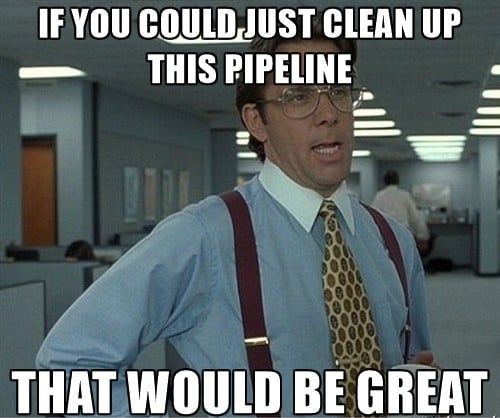Pipelines de vendas 101
Os princípios básicos para agitar seu processo de vendas b2b.

Dias longos, noites longas. Uma agenda cheia, um telefone quente e uma caixa de entrada lotada. O café é seu melhor amigo e os negócios não param. Parece a vida de um empreendedor de sucesso, certo? E, no entanto, em meio a essa montanha de papéis, notas adesivas e e-mails, você sente uma coceira. As vendas estão sendo feitas, mas elas parecem mais um acidente do que um sucesso. This isn’t working.
I used to just let my thoughts and ideas float, not bothering with structure and organisation. To-do lists and diaries were for suckers. As a student that meant missing chapters to study. As an entrepreneur it means missing deals and revenues. And while nobody likes bad grades, missing out on sales is worse. It’s dangerous for the survival of your business. Especially if you’re in the early stages.
What you need is a system. Something to bring order to the chaos that is your sales process. Something to keep track of your leads, so no deals fall through the cracks anymore. What you need, my friend, is a sales pipeline. We’ll show you why you need one, how to set up one up and what you can do to have it run as smoothly as possible.
Why do I need this, exactly? 🤔
If you want to excel at something, you first need to get the basics right. The basics of b2b selling are pretty straightforward. Someone is looking to improve his/her life and you’re trying to help them see why your product or service is the best one for the job. Bastante simples.
But humans are complicated creatures. Decision-making is not a linear process and external factors — like competitors — may come into play. As a sales person it’s your job to guide your prospect through the complexities that come with decision-making, straight to your solution.
A sales pipeline is a snapshot of where leads are in your sales process. It’s a visual, organised way to keep track of your potential buyers as they move through the different stages. Thinking of your sales process as a pipeline forces you to streamline your efforts into a repeatable and measurable process with clearly defined steps. It creates a shared understanding that will make your sales more actionable and scaleable.

The goal is to take your sales lead from stage to stage, all the way up to the definitive yes. If you fail, the deal is lost or can be put in the fridge to retarget later. The thing is that in sales you can’t control results. What you can control, are activities. Only when your whole team has a shared understanding of what your sales process should be, you’ll be able to optimise those activities and, in turn, improve results. In order to improve, you first need to know what your problems are.
Where is it that most deals go bad? What stage is taking the longest? How about stage-over-stage conversion? How many deals do I need to add to my pipeline to reach my goals? The sales pipeline will help you find out where you fail. Next, you’ll be able to turn those failures into best practices.
One step at a time ☝️
Chances are you’re already using the sales pipeline metaphor in approaching potential buyers. The typical stages of a sales pipeline follow the natural flow of a sales process. Of course, no sales pipeline outline fits all. Some stages may be more relevant to your sales process, others will overlap. The selling stages of your SaaS company will be different from those of a realtor. However, conceptually, a sales process goes something like this:
- Líder
The first time someone appears on your radar. He or she may be interested in your solution and you suspect they might be a good fit. Leads may just come to you, for example because they filled out a form on your website. Or you look for them, in places like conferences, social media or just ‘the Internet’. This is actually a pré-pipeline estágio. Você precisa primeiro descobrir se eles podem ser um cliente em potencial real para sua empresa antes de se tornarem uma oportunidade de vendas. - Contato
The first time you reach out and have actual contact. This will likely happen by email or call. Your goal is to verify the lead’s interest in your solution. If yes, you put them in the pipeline. If you find a lead from a positive reaction to a cold email or call, you can immediately put the lead in this stage. - Qualificação This is where you determine whether the lead is a good fit for your business as a customer. Are they within your target market? Do they have a real need for your solution? Do they have a budget and a clear timeline to buy in? Are you talking to the right people in the company? You’ll have to determine if you think a deal can be closed within the usual length of your sales process or not. This often involves a meeting and/or a series of calls. You’ll look for a match between your solution and your lead’s specific challenges. Don’t lose any time if there’s no match: just close the sales opportunity as lost.
- Proposta feita
By now, you’ve built enough momentum to make a formal offer. It’s now up to the lead to either buy or refuse. - Ganhar/Perder
The moment of truth. Time to get a signature on that bottom line… or not.
A sales pipeline is like an arcade game. As a player you have to get your lead from stage to stage. You only win if you can complete all 5 stages. One mistake on the way and it’s game over for that lead. This is why it’s key to have a proper amount of leads in the front of your pipeline. You’ll want to protect yourself from certain leakage in your pipeline and make sure you win enough deals at the end of the day. This quality of the sales pipeline to actively drive your sales process is one its most important reasons for you to use it.
Great! Where do I start? 🤠
Bem, pegue um pedaço de papel ou um monte de post-its e um quadro branco. Escreva seus estágios da esquerda para a direita e atribua cada um de seus leads atuais a um estágio. Você também pode adicionar outros dados: tamanho do negócio, data de fechamento prevista e representante de vendas que está trabalhando no negócio. Em seguida, faça ajustes à medida que você avança no tempo e nos leads em seu pipeline. Acompanhe a conversão de estágio em estágio e o tempo médio necessário por estágio.
Agora, em nome das árvores e do tempo, talvez você queira trocar a caneta e o papel por uma boa e velha planilha eletrônica. Essa pode ser uma ótima maneira de você começar a usar os princípios básicos do gerenciamento de pipeline de vendas. Elaboramos um modelo para você começar. Ele abrange todos os conceitos básicos do gerenciamento de pipeline de vendas. Não perca tempo!
Tools like Excel or Google Sheets can work fine for you as long as you’re not dealing with, let’s say, more than 10 potential customers at a time. But, as you grow bigger, the risk of losing overview and deals will do too. This is where you may want to consider using a proper CRM. Salesflare was developed to be simpler than pen and paper and more powerful than a spreadsheet.
Let’s get you a head-start 👊
So now you know what a sales pipeline is and why you need one. Time for you to get behind the wheel and start racing. Here’s three tips to make sure you make it off the start grid in pole position.
Crunch the numbers 📈
You don’t want to be driving in the dark. It’s dangerous and you have no idea where you will end up. Your pipeline’s conversion metrics are essential to keep you on the right track and will make your sales efforts scaleable.
Em primeiro lugar, o ciclo de vendas. Seu ciclo de vendas é o tempo necessário para que um comprador em potencial se torne um cliente. Em outras palavras: quanto tempo normalmente leva para os leads entrarem em seu pipeline e saírem pelo outro lado? Sempre que um cliente potencial demorar mais do que o normal, talvez seja melhor eliminá-lo e concentrar seus esforços em outros. O mesmo princípio pode ser aplicado a estágios individuais.

Second, stage-over-stage conversion. Knowing how many deals you close on average will give you an idea of how many leads you need to add to meet your objectives. As said before: you can’t control results, but you can control activities.
Vendas é um jogo de números. Fatos, números e ciência são o que você deseja para se manter no topo do seu processo de vendas. Somente quando todos os vendedores estiverem seguindo a mesma definição é que você poderá confiar no pipeline.
Flush regularly 🌊
Bigger isn’t always better. A pipeline stuffed with leads may seem like a good thing, but as a startup or small business you don’t have infinite resources. You’ll want to be selective in what you spend your time and energy on.

A eliminação de leads parecerá contra-intuitiva, até mesmo estranha. Mas isso é necessário para garantir um fluxo constante de leads e dinheiro em seu pipeline de vendas. Algumas coisas que você pode fazer para manter seus canais limpos:
- Be picky when it comes to lead qualification. A clean pipeline begins with the quality of the leads you put in in the first place. If you don’t really believe a lead could turn into a sale, it doesn’t belong in your pipeline. You want to focus your efforts on deals you feel confident of closing within a healthy sales cycle.
- Do spring cleaning every one or two weeks. Check up on all the deals in your pipeline and identify the ones that hold up the pack. You don’t have to get rid of them. Instead, put them in an alternative pipeline or in the fridge, to follow up on later.
- Focus on deals you’re confident of closing within a healthy sales cycle. If you’re a Salesflare user you can use the hot-or-not feature to detect hot leads. Sluggish ones will show up in your insights and home screen.
The Power of Automation 🤖
Seu pipeline de vendas precisa de um fluxo e você também. Use o Poder do hábito para manter o controle de seu pipeline. A inserção de novos negócios, a qualificação de leads em todas as etapas e a limpeza regular do pipeline são atividades importantes que podem ser facilmente incluídas em uma rotina diária. Transformar essas atividades em hábitos garantirá o máximo de produtividade com o mínimo de foco. Seu pipeline no piloto automático.

And you don’t have to stop there. Today’s technology makes it possible to run most other, mindless tasks automatically. No more admin work. Read here how Salesflare frees you of manually inputting data and automatically logs customer interactions. Zapier can make your CRM work together with all of your other productivity tools, like Google Sheets, MailChimp, Trello and Slack. You can just focus on the art of managing human relationships and closing sales while your pipeline runs itself.
Um estudo da Harvard Business Review de 2015 constatou uma correlação direta entre o gerenciamento eficaz do pipeline de vendas e o forte crescimento da receita. Usar um pipeline de vendas para gerenciar seu processo de vendas é a maneira mais rápida de acertar previsões, atingir cotas e ver o desempenho dos representantes de vendas ir além do que você imaginava ser possível. Não há armadilhas, você só precisa configurá-lo. Você pode começar hoje mesmo.
Dê uma olhada neste guia mais recente, mais longo e mais detalhado sobre pipelines de vendas se quiser saber mais.
We hope you liked this post. If you did, hit ❤ and spread the word! You can follow us @salesflare no Twitter para obter mais informações importantes sobre crm, vendas, growth hacking e startups.
- Os 20 melhores livros de vendas que Elon Musk provavelmente está lendo - fevereiro 14, 2023
- 6 maneiras infalíveis de fazer com que sua startup tenha seus primeiros 100 clientes - dezembro 6, 2022
- Como criar um funil de vendas que vende - setembro 2, 2021
